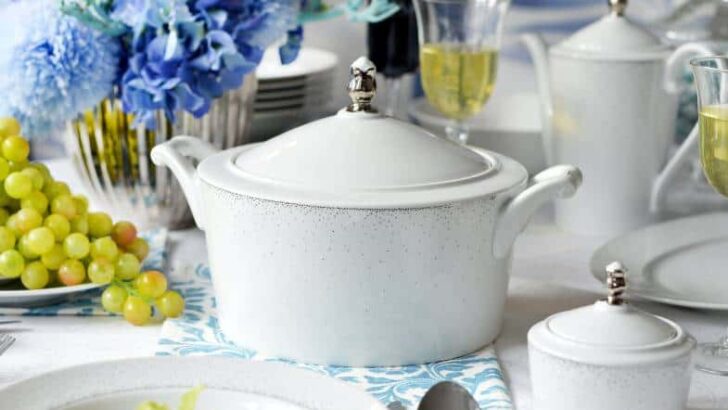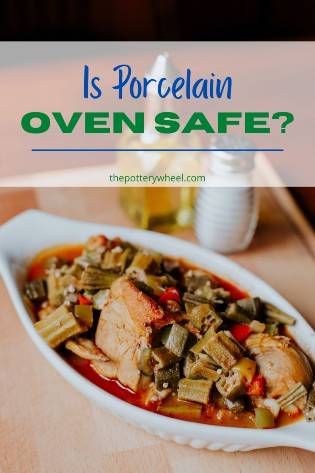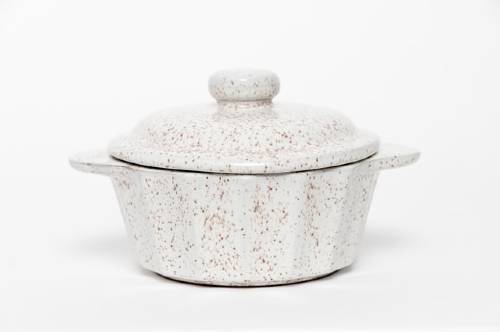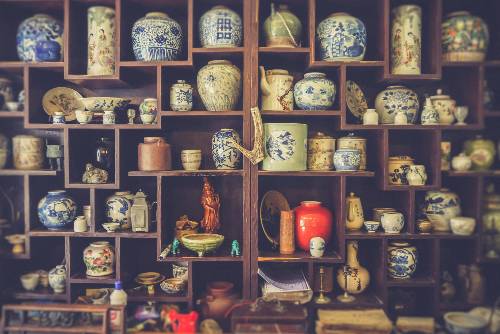Your cart is currently empty!
Is Porcelain Oven Safe? – Using Porcelain in the Oven
Published:
Last Updated:

Affiliate Disclaimer
As an affiliate, we may earn a commission from qualifying purchases. We get commissions for purchases made through links on this website from Amazon and other third parties.
I admit it, I’m a thrift store junkie. Recently I picked up a beautiful second-hand porcelain dish in a thrift store. It’s certainly large enough to cook a casserole in, but it got me wondering, is porcelain oven safe? So, I looked into it carefully and discovered the following…
Modern kitchenware that has been made by a reputable manufacturer as porcelain ovenware will be oven safe. It should have an oven safe symbol on the base. However, porcelain made in the 1970s and earlier may not be oven safe. In part due to the dangers of toxins leaching from older ceramic glazes.

So, if you are wondering if porcelain is oven safe, here are some things to consider….
Is Porcelain Oven Safe? – Some Factors to Consider
If a ceramic dish is being used in the oven, it needs to be able to withstand cooking temperatures. But it also needs to be strong enough to cope with a few inevitable knocks and bumps. Let’s take a look and see how porcelain fares with these criteria:
Your Cooking Temperature:
There are three main types of clay used for pottery and ceramic ware. They are earthenware, stoneware, and porcelain.
When ovenware is made, it is fired in a kiln. The process of firing means that it’s baked in a kiln at very high temperatures. A kiln is an insulated heating chamber like an oven, but it reaches much higher temperatures.
Out of the three types of clay used for ceramics, porcelain is most often fired at in the highest temperature ranges. Usually, porcelain will be fired at temperatures on or above 2372F (1300C).
Compared to the temperature of a kiln, the heat in a domestic oven is relatively low. So, porcelain is able to manage well as ovenware.
Typically, porcelain ovenware dishes are suitable for temperatures up to 500-572F (260-300C). The exact temperature that the ceramic ware can cope with will vary from one manufacturer to another. It’s best to check the user’s guide or the maker’s website.
Some ovenware is coated with porcelain enamel, rather than being solid porcelain. An example might be a cast-iron casserole dish that has a porcelain enamel coating.
Some porcelain-enameled dishes are oven safe up to 400F (204C). And others can tolerate temperatures up to 500F (260C). Again, it’s best to consult the user’s manual for your particular brand.
What About the Hob?
Being oven proof is not the same as being flame-proof. Most porcelain cookware, will not manage being used directly on a hob, even if they are oven proof.
The heat from a hob, whether it’s a flame or an induction plate is greater than the heat from an oven. In addition to being more intense, the heat from a hob is directed at one particular spot on the dish.
The localized heat creates a lot of stress in the porcelain. One part of the dish will be much hotter than another. Heating a dish will cause it to expand just a fraction.
Applying heat to one part of a dish causes that part to expand more than the cooler parts. This temperature differential can put the dish under so much stress that it can crack or shatter.
The tendency to crack under these conditions is to do with thermal shock. If ceramic ware breaks or shatters due to sudden temperature change, this is referred to as thermal shock.
It occurs when the ceramic material cannot manage rapid expansion or contraction caused by sudden temperature changes.
Some earthenware ceramics like terracotta can cope with being used on a hob, but porcelain will not.
Porcelain is Tough
Another feature of porcelain that makes it a good candidate for ovenware is that it is very strong and durable.
Porcelain is made out of fine-grained materials, so a porcelain finish looks refined. In addition to this, porcelain is often made out of kaolin clay, which is pure and free of impurities. This is the reason that porcelain is normally a lovely white color.
The properties of looking smooth, refined, and white can give porcelain a delicate appearance.
However, this appearance is deceptive. Porcelain is, in fact, a dense, hard material. As such it is a good candidate for being used as ovenware. Its durability means that it can survive inevitable bumps of being taken in and out of the oven.

The strength of porcelain comes, in part from a process called vitrification that occurs when it’s being made. As stated earlier, one of the key ingredients in porcelain is feldspars.
These are minerals, which when heated up turn into a glassy liquid. The glassy liquid fills up any pores between clay particles. When the dish cools after firing, the glass turns solid and creates a very hard, dense material.
As a result, porcelain dishes are vitreous. This is another way of saying that they are vitrified. In practical terms, this means that they are solid, dense, and non-porous.
By contrast, some other ceramic ware is not vitrified. An example of this is earthenware pottery like terracotta.
Terracotta does not have the same number of glass-forming materials in the clay. So, it does not vitrify when it is fired. As a result, it remains porous and weaker than porcelain.
So, whilst terra cotta might be more resistant to thermal shock, it is less tough than porcelain.
Porcelain is Non-Porous
The other advantage of porcelain is that it is, as mentioned above, non-porous. Because of the vitrification process described above, any gaps between clay particles in the porcelain are filled up with glass.
Most often, pottery that is being used as oven ware will be glazed. This means that it is coated with a glassy material that repels liquid. Because it has zero porosity, porcelain doesn’t need to be glazed to make it water-tight.
However, most often it will be glazed. This gives it a high shine surface that repels stains, smells, and bacteria. It is also easy to clean.
Beauty and Charm
One of the key properties of porcelain is that it is translucent. This means that it is glass-like and allows light to pass through it. Some porcelain dinnerware is very refined and translucent.
Porcelain ovenware tends to be thicker than dinnerware. Nevertheless, if you hold it up to the light you will likely be able to see the sunlight through the dish.
Whilst this is not a necessary property of good ovenware, it is definitely part of the charm of porcelain. And why not cook with something beautiful if you can.
So, we’ve looked at the properties of porcelain that make it oven safe. What sorts of things should you look out for that make porcelain unsuitable as ovenware?
Is Porcelain Oven Safe? – What to Look Out For
Porcelain dishes that have been manufactured and sold as bakeware or ovenware will be oven safe.
However, other types of porcelain are likely to be unsuitable to use in the oven. Highly decorative rather than functional ware, especially if it was produced prior to the 1970s is probably not oven safe. There are a few reasons for this.

Imagine you find a beautiful porcelain dish in a thrift store. It has delicate, elaborately designed handles and a painted design of various colors, perhaps with some gold-colored paint. Why is it better to assume that this dish is not oven safe? Let’s have a look at a few points of concern…
Safety Factors to Consider
- Although porcelain is a refined-looking clay, if it is used as ovenware, it needs to have sturdy construction. Spindly handles and delicate knobs on lids are at risk of breaking.
This is particularly the case when the porcelain is being heated and carrying the extra weight of the food. - Old and second-hand ceramics might have fine hairline cracks that are not easily visible to the eye. A hairline crack is a potential breeding ground for bacteria to grow if food accumulates in the crack.
Fine hairline cracks in porcelain will continue to weaken as the dish is used. The continual heating, cooling, and washing cycles being used will gradually open up a hairline crack.
This will create a structural weakness in the pot. This weak point in the porcelain is more likely to shatter in the oven or split whilst it’s carrying hot food.
- Another reason older cracked or chipped porcelain is not safe to use as ovenware is the issue of leaching. The glaze used to coat pottery with the lovely shiny water-tight glassy surface can contain metals. Some glazes contain metals like copper, lithium, or cobalt.
Leaching occurs when metals in the glaze seep into food or drink that is being prepared in the ceramic ware. The chances of leaching occurring increase if the glaze is cracked or chipped.
More about Leaching
Nevertheless, leaching can occur even if there is no evidence of damage to the glaze. A particular source of concern for the pottery industry has been the use of lead in ceramic glaze.
The presence of lead in the bloodstream can cause developmental delays and nerve damage in children (source). Over the 1980s and ’90s, there was a growing awareness of the dangers of lead in pottery glaze.
It is now industry practice for glazes containing lead to be classified as ‘not food safe’. And industrial manufacturers of porcelain and other ceramic ware will highlight that their products do not contain lead.
However, prior to the awareness of these dangers, many glazes did contain lead. As such, there is a risk of leaching when using older vintage ceramics.
It’s also worth considering where the porcelain ovenware was produced. Nowadays most ceramics produced to be retailed are regulated and have to meet safety criteria.
However, pottery that has been imported from less regulated regions may not meet stringent safety controls.
For example, researchers found that ceramicware in the Chinatown district of Philadelphia contained dangerous levels of lead (source). Also, ceramic ware containing lead is known to be imported from China and Mexico.
Final Thoughts
So, is porcelain oven safe? If the porcelain ware has been made by a reputable manufacturer or potter, then chances are it is oven safe. Oven safe pottery usually has a symbol on the base or states that it is ‘oven safe’. If this information is missing from the base of the pot, you can always reach out to the manufacturer. Usually, this information will be available on the user guide supplied with the ceramic ware. If it is not, it’s worth contacting the manufacturer to double-check. If like me you like to pick up vintage pottery at flea markets, it is safest to assume that your porcelain finds are not oven safe.



